B.C. Dee's Blog
March 14, 2016
History Repeats Itself
I am a big fan of Lapham’s Quarterly journal. I was lucky enough to have started reading the publication since its first issue. In it, every quarter, Louis Lapham compiles a timeless conversation on a single topic: love, youth, war, spies… The conversation is timeless because he selects (translated) texts that date back to the early Egyptians, the Romans, and the Greeks. He interposes those with philosophers, teachers, politicians, and captains of industry from every epoch of recorded human history, including modern and contemporary authors. What is most amazing to me in this journal is that humans have been wrestling with the same problems, questions, and issues forever. That is, an ancient text from 200 B.C.E. about governmental corruption still resonates two millennia later and can be responded to by a speech by Ralph Nader, for example.
In a similar vein, I recently ran across an article by Mark Twain wherein he examines the exact similarity between his “Jumping Frog of Calaveras County” and that of Athenian origin two thousand years earlier. In both stories, the pride of the owner of the frog brings about their downfall as a stranger fills the frog with stones or buckshot so that it cannot jump. Twain himself borrowed the story when he penned it in 1849, but he concludes that the 19th Century telling of the story had no relation to the early Greeks. He believes that history repeated itself. I do too.
My book, The Celebrated Jumping Frog, borrows no more from Twain than the title and the pride of the frog owner. Also, it’s a kids’ book and holds a gentle message about friendship using a boy and his frog as the story-telling vehicle. As such, it is unlikely to have an exact parallel in an earlier time… but it could. Even as dedicated a student of history as I am, I am continually awed by how similar we futuristic sailors of the planet Earth are to those who came before.
I would love to read your comments about juxtapositions and similarities that you have found between “now” and “then.” I hope you will feel free to write below –>
November 13, 2015
Disney’s Fairies Are the Wrong Way to Think About Learning
The Problem with Disney’s Fairies: Inborn Talents vs. Acquired Abilities
 The Disney Fairies, a multi-million-dollar franchise, are teaching our kids that some people just aren’t good at math, or sport, or dance, regardless of their effort and perseverance. This is not a feminist piece about the amount of skin female fairies show versus male fairies, nor about Rosetta, who is first and foremost, dedicated to fashion. I’m talking about the basic premise of Disney’s fairies: they have talents…unitary, immutable talents.
The Disney Fairies, a multi-million-dollar franchise, are teaching our kids that some people just aren’t good at math, or sport, or dance, regardless of their effort and perseverance. This is not a feminist piece about the amount of skin female fairies show versus male fairies, nor about Rosetta, who is first and foremost, dedicated to fashion. I’m talking about the basic premise of Disney’s fairies: they have talents…unitary, immutable talents.
Tinker Bell is a tinker fairy, she fixes and invents things. Iridessa is a light fairy, and she makes rainbows and helps sunflowers grow. Those are pretty cool talents, as talents go. But then there are baking-talent fairies, which is not a bad talent to have, but you probably don’t get out of the kitchen very often. Worse still are the polishing-talent fairies (see Vidia and the Fairy Crown, p 2)—their life is dedicated to polishing things other fairies make and other fairies use. It’s all a bit of an upstairs-downstairs caste system for my liking.
A fairy can only have one talent. In Tinker Bell’s first movie, she tried out a handful of tasks and, although at first she didn’t want to, she finally felt at home with a hammer in her hand. That is a very empowering image: a girl fairy with pom-poms on her shoes holding a large wooden mallet. Go girl! But, for the rest of her fairy life, she will live and die with that hammer.
Let’s forget, for the duration of this piece, that the relegation of menial tasks as talents essentially creates a tiered society with a permanent underclass. Instead, let’s think about what we are teaching our kids about education and ability. About perseverance and effort. About responsibilities and fault.
If you subscribe to the talent model of education, some folks are naturally good at math and other folks just aren’t. Some folks are good at sports, and others aren’t. Some people are “all thumbs” or have “two left feet” when it comes to coordination.
But there is an alternative model of education. It embraces a “growth mindset” and suggests that environment is responsible for young children’s intellectual development. You can take one group of first graders and tell them that they will be able to solve the problem if they try hard enough. You take a second group and tell them that the problem is hard, but if they’re good at math, they’ll be able to figure it out. From the first group, even those students who couldn’t figure out the answer persevered and put in effort until the end of the exercise. Those in the second group gave up early and started daydreaming long before the exercise was over.
The inborn-talent model often cites genetics—genes that scientists have yet to discover. But the results of the inborn-talent model are the product of a self-fulfilling prophecy. Tell someone that they are good at something and they’ll want to win your praise by being good at that thing. That means, they have to avoid challenges so they don’t prove you wrong. They’ll give up on tasks easier because they don’t want you to see them struggle. They have to disregard negative feedback because it contradicts the “fact” that they are good at the task. They will always compare their own success to the successes of others and will feel threatened by superior performance. Worst of all, they won’t branch out and try other activities that they might enjoy more and find more fulfilling.
The growth mindset, on the other hand disregards the deterministic view and heralds free will, effort, learning, and adaptation. Because all learning, in this model, is the result of overcoming challenges, folks will rise to the challenge, seeing it as an obstacle and not a barrier. Failure to overcome a challenge doesn’t lead to giving up, it leads to trying harder or seeking new knowledge in order to become better and, with effort and perseverance, overcome the challenge. Because the failure to overcome a challenge is not a failure in them as a person, they will use negative feedback to learn and improve. They will be inspired by the successes of others, and they will strive for ever-higher levels of achievement.
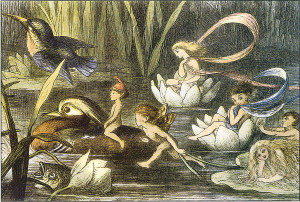 I am not demanding that parents ban their children from watching or reading about Disney fairies—they have some good, character-building lessons there. But I am suggesting that parents talk to their children about the fairies’ talents. Don’t let the opportunity pass to talk about Zarina, who was exiled from Pixie Hollow when she tried to improve on her role as a dust-keeper fairy. Tinker Bell represented the inborn-talent mindset and was afraid of Zarina’s innovations. Zarina even turned to pirates to find the environment where she could experiment and thrive. But in the end, she returned to Pixie Hollow and apologized for her rebelliousness. Inborn talent:1, growth mindset:0.
I am not demanding that parents ban their children from watching or reading about Disney fairies—they have some good, character-building lessons there. But I am suggesting that parents talk to their children about the fairies’ talents. Don’t let the opportunity pass to talk about Zarina, who was exiled from Pixie Hollow when she tried to improve on her role as a dust-keeper fairy. Tinker Bell represented the inborn-talent mindset and was afraid of Zarina’s innovations. Zarina even turned to pirates to find the environment where she could experiment and thrive. But in the end, she returned to Pixie Hollow and apologized for her rebelliousness. Inborn talent:1, growth mindset:0.
The premise of the fairies’ inborn talents can be a fun one. There are online quizzes for kids to find out what kind of fairy they would be. But that fixed-ability mindset has to stay in the books and toys. Kids have to be encouraged to try new things and fail. They have to look at the failures of their real-life idols and not just their successes. Help them acquire the habits of effort and perseverance with examples like Michael Jordan:
“I’ve missed more than 9000 shots in my career. I’ve lost almost 300 games. 26 times, I’ve been trusted to take the game winning shot and missed. I’ve failed over and over and over again in my life. And that is why I succeed.”
Let us no longer talk about “talent” and judge outcomes solely on performance. The road to mastery is long—In Malcom Gladwell’s Outliers, true mastery takes about 10,000 hours of dedicated practice. Otherwise, the pressure to perform will lead to a fear of failure and stagnation of ability. Worse, like those who say “I’m not good at math,” they will adopt a learned helplessness that will haunt them for the rest of their lives.
BC Dee has a Master’s in Education, a PhD, and more than twenty years in the classroom. He is the father to a magical four-year-old girl. And he is the author of several children’s books such as The Hiccupopotamus, The Girl Who Drank the Moon, and The Celebrated Jumping Frog. You can find out more about BC Dee at his website: http://www.bcd-123.com/
November 6, 2015
How About “Yes, And…” Instead of “No. Not!”
 I’m relatively new at the stay-at-home dad (SAHD) business. I started as a full-time SAHD on July 1, 2015. My daughter was already three years old at the time. I joined mommy groups and was the only father at lots of play dates. I have to admit, it got to me. SAHDs are stigmatized by society. At 2014 report explained that 51% of respondents thought that kids were better off when mom stayed home. Only 8% thought the same thing about dads.
I’m relatively new at the stay-at-home dad (SAHD) business. I started as a full-time SAHD on July 1, 2015. My daughter was already three years old at the time. I joined mommy groups and was the only father at lots of play dates. I have to admit, it got to me. SAHDs are stigmatized by society. At 2014 report explained that 51% of respondents thought that kids were better off when mom stayed home. Only 8% thought the same thing about dads.Then, I found the National At Home Dad Network (NAHDN). It changed my life to be part of a group of guys in similar situations. I felt validated, and that felt good. I was so moved by the group that I went to their 20th annual conference last month (October in Raleigh). It was another validation for the life my family has chosen and my role in it. I already know that I’m going again next year!
With all that said, I’m going to have to push back against a prevalent line of thought amongst SAHDs. We have shirts that say “When Daddy’s Doing It, It’s NOT Babysitting, It’s Parenting.” There are several voices railing against the national ‘dad cooks’ week. Scott Beson, author of The Working Dad’s Survival Guide, put it best: “Almost every dad I know is putting in the work to be a loving, hands-on, involved dad.” So come on, society, get off our case and recognize already!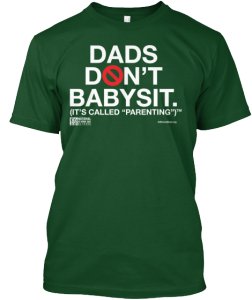
I agree, dads do need more recognition. I think that Homer Simpson did more harm to society’s view of fathers than any other factor in the last 25 years. So the social discourse is about absentee fathers who, when they are at home, are too tired or too busy to be a parent, much less a partner in parenting. There are some anecdotal examples of this kind of father, sure. But it is not the majority.
My problem with the way my group is trying to educate society is that they reject the compliments when they are at the park with their kids, or when they cook a meal. I say that we should take the compliment with thanks. Say “yes, I treasure my time with my kids.” If a colleague asks if you are participating in the national ‘dad cooks’ week, answer “yes, and I often cook throughout the year too.” Instead, we are all too likely to say “why did you single me out? Why aren’t you saying that to the moms?”
Dads in general, and SAHDs in particular, are missing the opportunity to lead society gently by the hand by saying “yes, and…” Getting our backs up and our noses bent out of shape over the Homer-Simpson-esque stereotypes is only widening the discourse gap. We close the opportunity for dialog when we rant about how unfair the stereotypes are. It is unfair because just about every dad I know is putting in the work to be a loving, hands-on, involved parent. But you catch more flies with honey than with vinegar. And it’s more relaxing too.
Building Respect One Drop at a Time

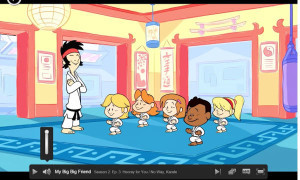 As I was watching “My Big Big Friend” with my daughter yesterday, there were some kids in a karate class. They were all portrayed to look like the diverse cast of regular kids (white, latino, African-American) EXCEPT for the teacher. Like no other adult on the show, the teacher of karate was drawn with very little detail except for slanted lines for eyes (get it, he’s Japanese).
As I was watching “My Big Big Friend” with my daughter yesterday, there were some kids in a karate class. They were all portrayed to look like the diverse cast of regular kids (white, latino, African-American) EXCEPT for the teacher. Like no other adult on the show, the teacher of karate was drawn with very little detail except for slanted lines for eyes (get it, he’s Japanese).
Today, I ran into this article about a non-profit group of Alaskan Natives who engineered a game that is “culturally appropriate” without merely “appropriating” the characteristics of the group.
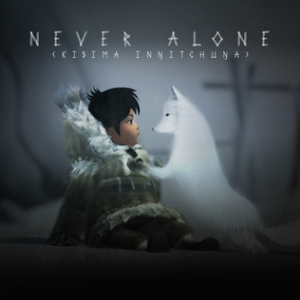 Here’s a description of the game: Nuna, the game’s hero, teams up with an arctic fox to find the source of the blizzard that’s threatening her community. Players explore themes of resourcefulness, cooperation, and the transfer of knowledge from one generation to the next through the beautifully rendered gameplay.
Here’s a description of the game: Nuna, the game’s hero, teams up with an arctic fox to find the source of the blizzard that’s threatening her community. Players explore themes of resourcefulness, cooperation, and the transfer of knowledge from one generation to the next through the beautifully rendered gameplay.
In Isabel’s 2-K program last year, kids painted shirts for Thanksgiving. She wore the shirt again yesterday. It was her “Indian” shirt. I corrected her gently–we say “Native American.” This is especially important because my mom does and has lived in India for more than 20 years. My mom lives among Indians. My daughter had an appropriated Native American on her shirt.
Particularly when it comes to respect, every little thing is a drop in the bucket. But once the drop is in the bucket, it can’t be taken out.
November 3, 2015
Another Dad Stays Home
I’m going to try my hand at self promotion. I plan to reach out to the local news community and see if they might be interested in the following. I would love to hear your comments!
The Trend Continues: Another Dad Stays Home
The books are short with big print and lots of pictures. The stories are in rhyming verse. These are not the typical fare you’d expect from a political science professor who specializes in mega-cities and urban poverty. But with three children’s books under his belt and another on the way, author BC Dee (the pen name of Dr. Bryan Williams) is winning the hearts and minds of young children around the world. He is also one the small population of stay at home dads (SAHD) in the US.
 “I felt like I was missing out on my daughter’s life,” says BC Dee. “Her first two years flew by.” Changing careers to become a stay at home dad “has been the third-best choice in my life, after marrying my wife and having a child.”
“I felt like I was missing out on my daughter’s life,” says BC Dee. “Her first two years flew by.” Changing careers to become a stay at home dad “has been the third-best choice in my life, after marrying my wife and having a child.”
In the United States, there are around 425,000 fathers who stay at home primarily to care for their children and family. In comparison, there are more than seven million mothers (more than 18 times as many) who are making the same choice. Of the nearly two million at-home dads, the percentage who specify that they stay home to take care of their children has risen from around 5% in 1989 to around 21% in 2014. Nevertheless, stay-at-home dads fight a social stigma.
 In a 2013 Pew Research Center survey, 51% of the respondents felt that children would be better off if the mother stayed at home. Only 8% felt that the father would have the same, positive effect. “I had to work hard with the change in my identity,” BC Dee said. “I was transitioning from a well-respected profession and moving into one that is often referred to as ‘babysitting,’ when fathers do it.”
In a 2013 Pew Research Center survey, 51% of the respondents felt that children would be better off if the mother stayed at home. Only 8% felt that the father would have the same, positive effect. “I had to work hard with the change in my identity,” BC Dee said. “I was transitioning from a well-respected profession and moving into one that is often referred to as ‘babysitting,’ when fathers do it.”
 “I suppose I became an author so that I could feel like I was contributing to the family, which is silly because my biggest contribution is the time I spend with my daughter.” BC Dee cites his daughter as his inspiration for his stories such as The Girl Who Drank the Moon, The Hiccupopotamus, and The Celebrated Jumping Frog.
“I suppose I became an author so that I could feel like I was contributing to the family, which is silly because my biggest contribution is the time I spend with my daughter.” BC Dee cites his daughter as his inspiration for his stories such as The Girl Who Drank the Moon, The Hiccupopotamus, and The Celebrated Jumping Frog.
He is currently working on a middle-grade fantasy novel that is “based on unanswered questions in Disney’s fairy stories. For example, why do fairies use pixie dust? Where do they keep the pixies? Do the dust-keeper fairies only package the dust, or do they have more nefarious tasks.” BC Dee has turned to the crowd-funding publisher, Inkshares, to launch his first novel: The Pixie Wars.
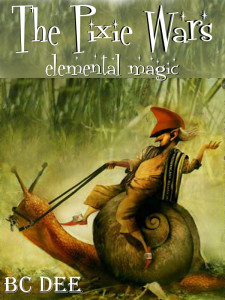 “I’m also trying to contribute to the at-home dad community,” BC Dee said. “The National At Home Dad Network holds an annual conference. I went to the twentieth in Raleigh in October. It was eye opening and life changing.” With plenty of humor, this community is very active on social media, and in local meet ups. BC Dee says “the ideas and education we trade is helpful, but the moral support is priceless.”
“I’m also trying to contribute to the at-home dad community,” BC Dee said. “The National At Home Dad Network holds an annual conference. I went to the twentieth in Raleigh in October. It was eye opening and life changing.” With plenty of humor, this community is very active on social media, and in local meet ups. BC Dee says “the ideas and education we trade is helpful, but the moral support is priceless.”
Source: Gretchen Livingston, 2014. “Growing Number of Dads Home with the Kids: Biggest increase among those caring for family.” Washington, D.C.: Pew Research Center’s Social and Demographic Trends project, June.
Human Interest Story
I’m going to try my hand at self promotion. I plan to reach out to the local news community and see if they might be interested in the following. I would love to hear your comments!
The Trend Continues: Another Dad Stays Home
The books are short with big print and lots of pictures. The stories are in rhyming verse. These are not the typical fare you’d expect from a political science professor who specializes in mega-cities and urban poverty. But with three children’s books under his belt and another on the way, author BC Dee (the pen name of Dr. Bryan Williams) is winning the hearts and minds of young children around the world. He is also one the small population of stay at home dads (SAHD) in the US.
 “I felt like I was missing out on my daughter’s life,” says BC Dee. “Her first two years flew by.” Changing careers to become a stay at home dad “has been the third-best choice in my life, after marrying my wife and having a child.”
“I felt like I was missing out on my daughter’s life,” says BC Dee. “Her first two years flew by.” Changing careers to become a stay at home dad “has been the third-best choice in my life, after marrying my wife and having a child.”
In the United States, there are around 425,000 fathers who stay at home primarily to care for their children and family. In comparison, there are more than seven million mothers (more than 18 times as many) who are making the same choice. Of the nearly two million at-home dads, the percentage who specify that they stay home to take care of their children has risen from around 5% in 1989 to around 21% in 2014. Nevertheless, stay-at-home dads fight a social stigma.
 In a 2013 Pew Research Center survey, 51% of the respondents felt that children would be better off if the mother stayed at home. Only 8% felt that the father would have the same, positive effect. “I had to work hard with the change in my identity,” BC Dee said. “I was transitioning from a well-respected profession and moving into one that is often referred to as ‘babysitting,’ when fathers do it.”
In a 2013 Pew Research Center survey, 51% of the respondents felt that children would be better off if the mother stayed at home. Only 8% felt that the father would have the same, positive effect. “I had to work hard with the change in my identity,” BC Dee said. “I was transitioning from a well-respected profession and moving into one that is often referred to as ‘babysitting,’ when fathers do it.”
 “I suppose I became an author so that I could feel like I was contributing to the family, which is silly because my biggest contribution is the time I spend with my daughter.” BC Dee cites his daughter as his inspiration for his stories such as The Girl Who Drank the Moon, The Hiccupopotamus, and The Celebrated Jumping Frog.
“I suppose I became an author so that I could feel like I was contributing to the family, which is silly because my biggest contribution is the time I spend with my daughter.” BC Dee cites his daughter as his inspiration for his stories such as The Girl Who Drank the Moon, The Hiccupopotamus, and The Celebrated Jumping Frog.
He is currently working on a middle-grade fantasy novel that is “based on unanswered questions in Disney’s fairy stories. For example, why do fairies use pixie dust? Where do they keep the pixies? Do the dust-keeper fairies only package the dust, or do they have more nefarious tasks.” BC Dee has turned to the crowd-funding publisher, Inkshares, to launch his first novel: The Pixie Wars.
 “I’m also trying to contribute to the at-home dad community,” BC Dee said. “The National At Home Dad Network holds an annual conference. I went to the twentieth in Raleigh in October. It was eye opening and life changing.” With plenty of humor, this community is very active on social media, and in local meet ups. BC Dee says “the ideas and education we trade is helpful, but the moral support is priceless.”
“I’m also trying to contribute to the at-home dad community,” BC Dee said. “The National At Home Dad Network holds an annual conference. I went to the twentieth in Raleigh in October. It was eye opening and life changing.” With plenty of humor, this community is very active on social media, and in local meet ups. BC Dee says “the ideas and education we trade is helpful, but the moral support is priceless.”
Source: Gretchen Livingston, 2014. “Growing Number of Dads Home with the Kids: Biggest increase among those caring for family.” Washington, D.C.: Pew Research Center’s Social and Demographic Trends project, June.
October 24, 2015
The Sun Didn’t Rise: An Illustrated Children’s Book

Next month, I plan to launch an illustrated children’s book called “The Sun Didn’t Rise.” It is a farm-to-table cause-and-effect story that kids can love on many different levels. So I was very excited today when I saw MilkPEP’s full-page advertisement in the NY Times electronic edition (*note, it’s a paid advertisement).
I’m don’t generally like advertisements, but I always like good education. This organization wants you to know your local milk farmers, and how they take care of Americans’ diets through careful practices and dedication to their cows.
I am happy to find this new group of allies in my quest to write compelling and educative children’s books.
What do you think of the idea of a farm-to-table picture book for kids? Let me know in the comments.
October 23, 2015
Six-Question Survey About The Pixie Wars
Dear patrons of the arts,
As you may know, I have a book that is up for crowdfunding on Inkshares. One of the neatest aspects of crowdfunding in this way, particularly while the book is in its second draft, is that YOU can participate and make the book better!
If you haven’t yet, please read the sample on Inkshares. You can read the sample freely with no obligation to pledge your support.
Even if you haven’t pledged your support, I would still value your participation in this six-question survey. It’s anonymous, and will help me with the direction of the use of swearing, character titles, and character names.
If you have any other ideas or suggestions, please leave them in the comments of this post.
Thanks so much for being a part of this exciting process!
All my best,
BC Dee
Loading…
October 21, 2015
A Pixie’s Plea
Hi, it’s me, Bryan (a.k.a. BC Dee, author of children’s books). I just got this letter from a pixie. She sounds kind of desperate. Maybe we should help.
<<<<<<<<<>>>>>>>>>
Dear human person,
We pixies are in danger, and we need your help!
I am Alaina, daughter of The General, the commander of our army. He is a stubborn and prideful pixie, so he cannot know that I am asking for your assistance. Because I know his weaknesses so well, and because our peril is so great, I write to you for the greater good.
The problem is that the fairies’ lifestyle and entire economy is only possible because it is buoyed by “pixie dust.” Everybody knows that, and the fairies even brag about it. But the source of pixie dust is a closely guarded secret among fairies, and merely a rumor among us pixies. “Dust keeper fairies” carry out the dark duty of finding and enslaving pixies who are capable of magic—a kind of magic that fairies cannot touch.
These poor slave pixies live horrible, painful lives and die young. We have to channel magic. It is very much like how your human electrical cords channel electricity to make your lightbulbs shine. Slave pixies are turned into exactly this kind of electrical cord for magic. They live their days writhing in agony until death finally takes them.
Fairy slavery of pixies has been going on for more than one thousand years, but now the fairies have a new leader: the self-proclaimed ‘emperor’ Oberon. He appears set upon attacking our lands and enslaving all of our people. He claims that he is the “sire of all fairies, and ruler of all magical domains.” We expect the fairy army, along with mercenary trolls, to attack us any day now.
There must be something you can do to help us. To save us. I have documented all that I can, and I implore you to read it.
Humans are worldly and learned. I am sure that you will think of something, once you know the situation.
Please visit https://www.inkshares.com/projects/the-pixie-wars-elemental-magic/ and read what I have written.
You are our last and only hope. I pray you will help us.
Most sincerely,
Alaina
<<<<<<<<<>>>>>>>>>

October 20, 2015
How Often Do You Laugh Out Loud?

The more I interact via social media, the less I like the constraints to communication implicit in emoticons and thumbspeak (my term for the ubiquitous acronyms in text messages).
It is always easier to criticize than create, so today, I have dedicated a bit of time to add to the thumbspeak dictionary: CTM (i.e. chuckle to myself). Maybe I’m just not the kind of guy who laughs out loud at so many of the humorous offerings on the internet. But I do find them funny. Chuckling to myself, inaudible to anyone else, is my usual reaction.
I made a visual aid to help explain what I mean. For me, this visual aid is a CTM moment. Watching Mel Brooks’ early films make me lol.



